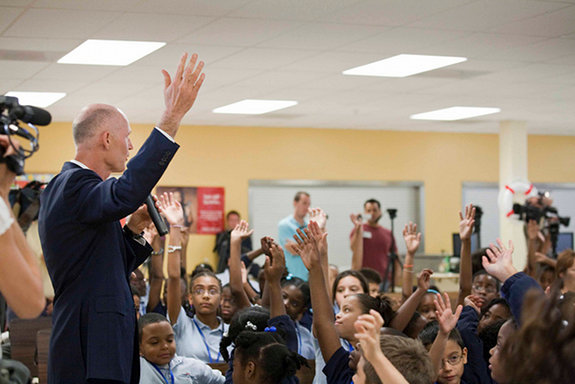
Gov. Rick Scott visited North Broward Academy of Excellence, a charter school, in September 2010. (Photo courtesy of Rick Scott.)
By Ralph De La Cruz
Florida Center for Investigative Reporting
As public school students and educators throughout Florida prepared to return to schools that have fewer teachers, larger classes and smaller budgets, a for-profit charter school company, Charter Schools USA, paid for 2,000 employees to attend a pep rally. The rally included controversial charter schools proponent Michelle Rhee and Gov. Rick Scott — the man who pushed for $1.35 billion in cuts for public schools and increased funding for charter and virtual schools.
Charter schools are privately run, often for profit, but publicly funded.
Addressing the conspicuous display of spending at such a lean time for public education, Scott said, “Leave it to the local educators to decide how to best spend their money.”
As the Orlando Sentinel pointed out, Scott was not referring to local public schools, but rather his “baby” — charter schools.
Even more striking — given that one of the strongest criticisms against charter schools is that they are largely unaccountable — was the company’s decision not to reveal what the rally cost.
“Any of the extra events that Charter Schools USA puts on come out of their own budget,” said spokesman Colleen Reynolds. “It does not affect the schools at all.”
Charter Schools USA makes its money by charging a management fee to run the schools. That money is a percentage of the $150 million in tax money that the state pays the company to run its 25 Florida schools. At just one school in Osceola County, Charter Schools USA picked up $822,182 in administrative fees this year.
And the tax money seems to be increasing for charter schools even as it decreases for public schools.
As state Rep. Dwight Bullard of Orlando pointed out in a letter to Florida Education Commissioner Gerard Robinson, “Adding insult to injury, the Legislature even had the gall to give no money for capital improvements and maintenance to the nearly 3,000 traditional public schools, yet gave the state’s 350 charter schools $55 million.”
Bullard is asking Robinson to look into the details of the rally at the upscale Rosen Plaza Hotel and release the facts and figures to the public.
Perhaps Rhee, the former Washington D.C. education chief whom Scott courted to become Florida’s education commissioner, didn’t realize how tone-deaf she sounded when she said onstage: “I think what we have to be focused on right now is to take the money we do have and putting it toward the most effective strategies.”
Scott certainly didn’t have any qualms about the taxpayer-funded expenditure.
“The reason people do things like this in business is that by getting together and sharing ideas and inspiring them to the best, often it works, and if that is what happens, then I think it’s a good use of money,” Scott said.
Such conspicuous use of tax money might also go over better if charter schools didn’t have such a poor history of performance. A 2009 Stanford University study found that only 17 percent of charter schools reported academic gains that were significantly better than public schools, while 37 percent reported gains that were worse than public schools. And the other 46 percent were about the same as public schools.
Here in Florida, the Sun-Sentinel points out that when school grades came out this summer, charter schools earned nearly half of the 31 F grades handed out statewide — although the 350 charter schools make up just 10 percent of the state’s schools.
And then there are the lessons offered by vouchers and privatization in Chile. Begun in the 1980s under dictator Augusto Pinochet, but subsequently continued by both conservative and liberal governments, the move toward vouchers and privatization was supposed to offer greater educational access to all. In a 1995 essay for the conservative Cato Institute, noted economist Milton Friedman used Chile as an example of why the United States needed to privative public education.
Good thing we didn’t follow Chile’s example. The vouchers and privatization experiment resulted in greater inequality and less educational access than ever. Today, 80 percent of Chile’s college students attend private institutions.
So this summer, hundreds of thousands of Chileans protested and rioted to demand greater government involvement in the educational process.
